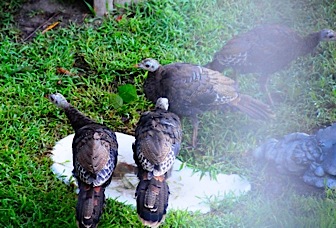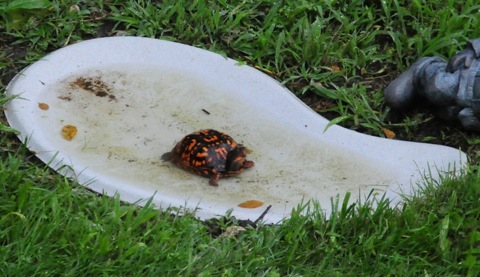-
Ant Baffles and Ant Moats for Hummingbird Feeders
Moat: Webster’s defines it as “A wide, deep ditch, usually filled with water, surrounding a medieval town or fortress”. And most ant moats are filled with water to alleviate the pesky ant problem… you see, ants can’t swim! They can not cross the water inside the ant moat to gain access to sweet nectar.
Some ant moats however, operate beautifully without the use of water. This pretty wooden ant moat is deemed the “Anti-Ant Moat” and works perfectly. It does so because a special material is inserted on the under-side of the moat. Now I’m not quite sure what it is, but I do know ants avoid it. The reason I’m so sure of this is because I use one of these non-water ant moats with this substance in it, a green plastic one that h
as got to be at least five years old… and it still works great!
One trick when using ant moats is to add a drop of salad oil to the water during extreme heat. This helps to slow the evaporation process, because an empty ant moat just won’t cut it. So what if you’ve got a staked hummingbird feeder? Ants can be a real pain in the butt-crawling directly up the stake and ruining fresh nectar. Hummers won’t drink nectar contaminated with ants. This is where ant baffles are used, with staked hummingbird feeders. They’re pretty much the same design as standard ant moats, but placed on the stake and used upside down. Now
how would an upside down ant moat hold water you ask? Petroleum Jelly… coating the underside of the ant baffle with this handy stuff keeps ants at bay!
Don’t ever let ants ruin your hummingbird experience, or your nectar again. Use ant baffles and ant moats to keep ants out!
Oh yeah… and the simple nectar recipe: 1 cup plain table sugar to 4 cups of water-nothing else. No red dye needed either. Never use honey or artificial sweeteners as they’re harmful to hummingbirds. You don’t even need to boil the water, but using some will dissolve sugar quicker and more effectively. Right now, hummers need to double their body weight in preparation for the long migration home. Central and South America are very far away, so the nectar solution may even be a little stronger at 1:3 instead of the usual 1:4 ratio.
-
Not Crazy for Butterfly Feeders – but these…
Puddlers! Everyone seems to adore them, everyone as in wildlife that is. The severe drought in the south has taken its toll not only on the land, but wildlife as well. In Arizona and Texas, many mammals are abandoning their young in search of food and water. This summer has been a sad state of affairs as far as miserable weather.
Butterfly Feeders will only go so far in attracting the winged jewels, because habitat is really the key. Leaf misters and bird baths around our Georgia yard have been brimming with constant activity for the past two months. Precious water, inexpensive but life-saving for so many creatures, it’s been the number one attraction this season!
Below one of our two leaf misters is a butterfly puddler. It’s been frequented by many other critters besides butterflies though! These wild turkeys hung around for close to an hour on this particular visit. Even Mr. Turtle visited the puddler one day and decided to take a swim!
With the Fall Migration gearing up, you can greatly increase the odds of a successful journey for many birds by offering fresh water. Keep hummingbird and butterfly feeders filled with fresh nectar. Hurricanes and storms in the north have ravaged much of the landscape. Many of the plants and nectar-producing flowers have been damaged and ravaged by the rains and floods. Hummingbirds and butterflies depend heavily on these natural sources for food. So please remember to help out local wildlife by keeping nectar feeders fresh and full and always offer some kind fresh water source.





